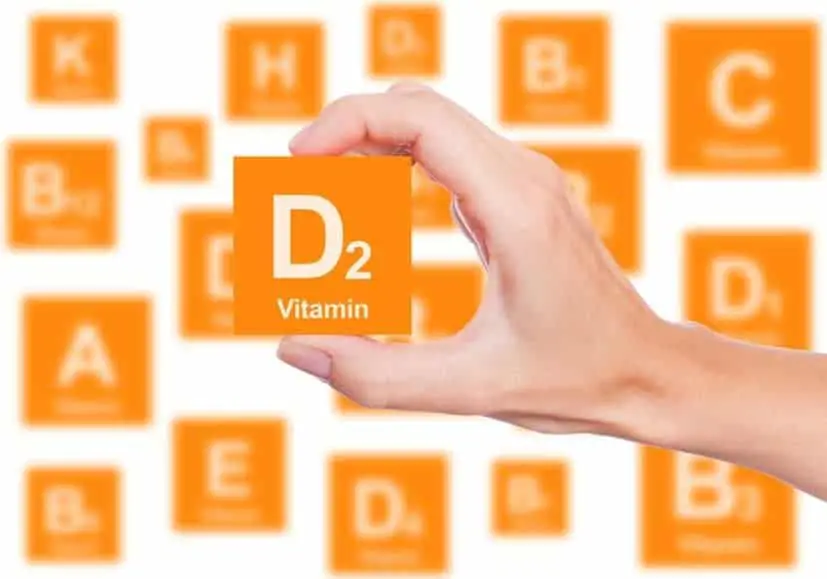It’s time to tackle the rather big topic of vitamin D as relates to plant-based eating. I’ll be breaking with the usual format. I’ll present a lot of the same type of information as covered in previous vitamin articles but within the context of frequently asked questions about vitamin D and plant-based diets.
Below are the most common questions, many of which have overlapping explanations. The table of contents is there so that you can just zip right down to the content you’re looking for.
Is Vitamin D Vegan?
In terms of food sources, vitamin D is among the least vegan-friendly nutrients along with vitamin B12 and some of the long-chain EFAs. Thanks to modern technology, it’s not impossible to meet vitamin D needs through food and/or supplementation alone. In this article, I hope to help you do just that.
What Is Vegan Vitamin D?
Vitamin D that qualifies as vegan comes in two forms:
- Vitamins D2 (ergocalciferol). This form is found naturally in plants, yeast, and fungi and thus qualifies as vegan. It’s also commonly added to fortified foods and supplements.1
- Vitamin D3 (cholecalciferol) harvested from lichen, a composite organism arising from algae or cyanobacteria.2-4
How Much Vitamin D Do Vegans Need?
The bioavailability of vitamin D in vegan sources is as good as that found in animal products. Also, most people (vegan and omnivore) acquire the bulk of their vitamin D from sun exposure.14 As such, the vitamin D needs of vegans are the same as that of non-vegans.7
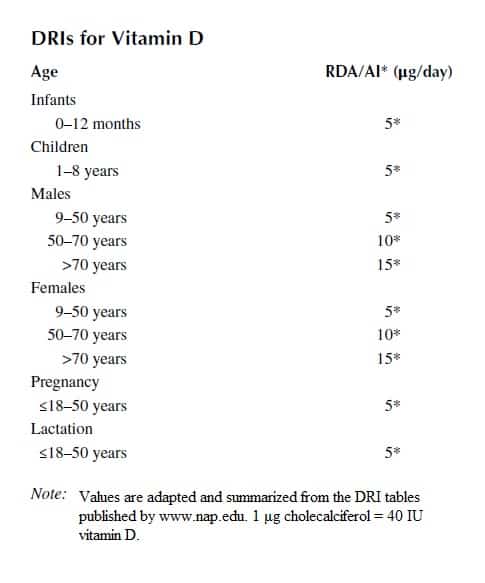
Source: Micronutrients in Health and Disease. Kedar Prasad – Crc – 2011
Where Does Vegan Vitamin D Come From?
Vitamins D2 (Ergocalciferol)
Shitake Mushrooms
Mushrooms, in general, naturally contain some vitamin D2.5,6 The best source is shitake mushrooms that have been exposed to UV light under controlled conditions.7
Because they contain high amounts of provitamin D2 (a vitamin D precursor), UV and sunlight-exposed mushrooms can be an excellent source of vitamin D.
After exposure to UV radiation, the provitamin D2 is isomerized to previtamin D2 at which point it is rapidly converted to vitamin D2. The process is very similar to how previtamin D3 is converted to vitamin D3 in human skin.
Supplements and Fortified Foods
Again, this form of vitamin D can often be found in food products and supplements. You’ll just have to scan the ingredients label to know whether a specific product has it.1
Vitamin D3 (Cholecalciferol): Supplements
Very few foods in nature—plant or animal—contain vitamin D. Unfortunately, of the few foods that do offer meaningful amounts of D3, all are of animal origin—namely, fish oils, fatty fish (such as tuna, salmon, and mackerel), egg yolks, beef liver, and cheese.8-10
For this reason, the only vegan-friendly vitamin D3 you could possibly encounter in food would be lichen-derived D3 added to food products. To my knowledge, this type of D3 is used in (select) supplements, more so than food products.
How Is Synthetic Vegan Vitamin D Made?
Vitamin D2 (Ergocalciferol)
Manufacturers produce vitamin D2 from fungus or yeast. It’s usually produced synthetically from radiating the compound ergosterol derived from the mold ergot. It was first produced in the early 1900s by exposing various foods to UV light.
Vitamin D3 (Cholecalciferol)
Manufacturers use a number of methods to produce vitamins:
- Extraction methods—finding the vitamins where they naturally occur in nature and extracting them from crude material.
- Chemical synthesis—catalyzing reactions using precursors to produce the vitamins.
- Biotechnologies—for example, using certain microbes to produce vitamins. It’s similar to how our intestinal microbes naturally produce vitamins K2 and B12. By cultivating the right cultures using various technologies, researchers can produce vitamins in large quantities.
Non-vegan vitamin D is made via #2. By harvesting the D3 precursors from a waxy substance secreted by the sebaceous glands in wooled animals, manufacturers are able to produce large quantities of D3 for supplements and food fortification.11-13
It can also be acquired from fish and fish liver oils (extraction).14
Anway, vegan vitamin D3 is acquired via the extraction methods. It turns out that there are certain edible forms of lichen that grow on trees and rocks in specific locations around the world.15
Does Vegan Vitamin D Work (Is It Effective)?
In short, vegan vitamin D is effective. However, vitamin D2 may be less potent in high doses. Though certain forms may be less potent, all vegan-friendly vitamin D is endorsed by government health organizations for meeting vitamin D needs.7
Lichen-derived vitamin D3 functions every bit as well as vitamin D3, derived any other way. The efficacy of vitamin D2 in certain respects is a bit more controversial. Both D2 and D3 were shown to be effective in raising serum 25(OH)D levels.16 Which is the main thing. It’s just that D2 may be less potent.
According to the NIH, “Firm conclusions about any different effects of these two forms (vitamins D2 and D3) of vitamin D cannot be drawn. However, it appears that at nutritional doses vitamins D2 and D3 are equivalent, but at high doses, vitamin D2 is less potent.”7,17,18
In the past, the two forms were traditionally regarded as equivalent for three reasons:
- They both demonstrated the ability to cure rickets (the main manifestation of vitamin D deficiency in children).
- The same metabolism and actions in the body of both forms are largely identical. For example, vitamin D2 is metabolized to calcitriol by the same enzymes as vitamin D3 (1-hydroxylase and 25-hydroxylase). However, its metabolism produces byproducts not generated by D3. For this reason, it’s been suggested that D2 may be less efficient compared to D3 in producing calcitriol.19
So, yes—vegan vitamin D does work. But, if it would put your mind at ease, you may want to try one of the vegan-friendly D3 supplements.
Which Vegan Foods Contain Vitamin D? And How Do I Know If Vitamin D that I Encounter Is Vegan?
I wrote an entire article on this, titled How to Tell If Vitamin D Is Vegan. But, I’ll summarize some of the main points here.
While vitamin D2 is always vegan, vitamin D3 is rarely vegan. The vitamin D3 found naturally in food is never vegan, and the only D3 used in supplements and fortified foods qualifying as vegan is vitamin D3 sourced from lichen.1
At this point in time, most vitamin D present in food is in the form of vitamin D2. Plant milks can be a great source of vitamin D for vegans.
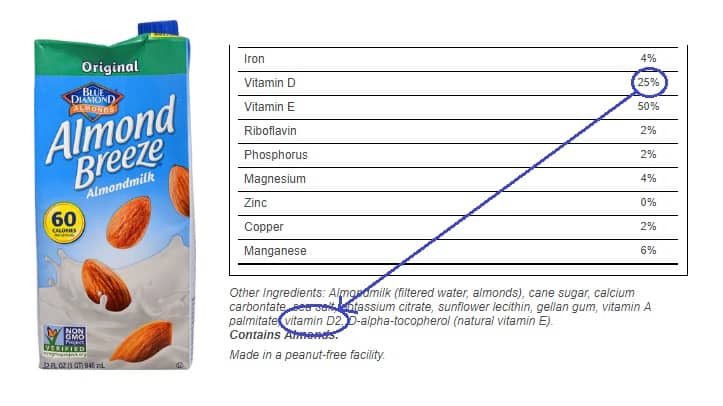
To check the vitamin D content of your favorite foods, I recommend visiting http://smartlabel.org/products. It’s a site dedicated to transparency when it comes to ingredients used in foods.
After arriving at the website, type in the food you’re looking for.

Locate and click on the product, then look for the ingredients tab.
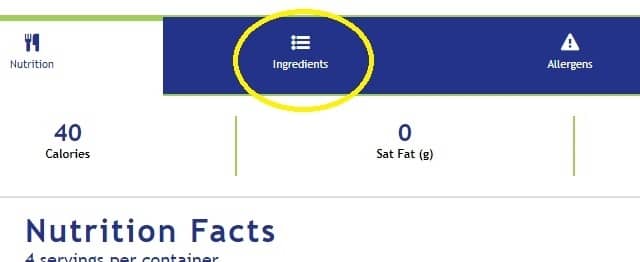
Scroll down to see the type of vitamin D used in the food.
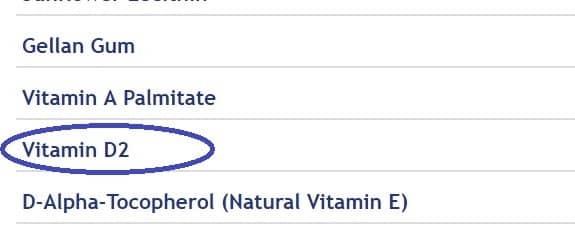
Which Vegetables Contain Vitamin D?
Unfortunately, there are no known commonly consumed vegetables that contain vitamin D. In nature, very few foods contain the vitamin which is why there are fortification programs for the general population—whole milk has vitamin D added to it.20
That’s not to say that vitamin D can’t be found in the plant kingdom, it’s just that you won’t run across it in any commonly eaten plant foods. Lucinda, B. et al. in the study, In Pursuit of Vitamin D in Plants, noted that vitamin D3 has been found in the Nightshade family, but research in that area has mostly focused on the leaves, which are poisonous in large amounts.
The researchers went on to say, “Quantifiable 25(OH)D3 was detected in the UV-treated leaves of waxy leaf nightshade, tomato plant, and bell pepper, and was also in the untreated leaves of waxy leaf nightshade.”21
Vitamin D from these obscure sources has yet to be brought to market.
Are Vegans Vitamin D Deficient?
It may come as a surprise, but vegans are not characteristically deficient in vitamin D. According to NIH, those at risk for vitamin D deficiency include:7
- Breastfed infants
- People with limited sun exposure
- Older adults
- People with darker skin
- The obese or who have had gastric bypass surgery
- People with IBD and other conditions that can cause fat malabsorption.
How is it that vegans aren’t considered at high risk of vitamin D deficiency with such scarcity of the vitamin in vegan foods? Because most people meet the majority of their vitamin D needs via sun exposure. For this reason, omnivores fail to do a much better job of getting sufficient vitamin D compared to vegans. Vitamin D deficiency tends to be frequent in all age groups, regardless of diet.22,23
According to Daiva Gorczyca in Vegetarian and Plant-Based Diets in Health and Disease Prevention, the prevalence of vitamin D deficiency in the general population may be explained by a couple of factors:24
- Foods rich in vitamin D (most of which are animal products) are not very popular in standard diets.
- Sunlight exposure which provides vitamin D is hindered by the use of creams with UV filters. While the use of such creams is important in the reduction of skin cancer risk, they also decrease the synthesis of vitamin D to near zero.
These factors likely account for why most studies have failed to show vegetarian diets (even strict vegan diets) to directly cause vitamin D deficiency.25
There is a distinction to be made: vegans tend to have lower levels of vitamin D compared to other diet groups, but they are not typically deficient in the vitamin. For example, the EPIC-Oxford study showed blood levels of the vitamin amongst vegans to be adequate (55.9 nmol/l), though lower compared to the other diet groups included in the study.26
Nevertheless, vitamin D deficiency is common and vegans are no exception—especially considering the lack of D-rich food sources.27 And there have been a few studies that have found trends of inadequate intake and nutrient status of vitamin D in vegans.28-30
So, it is an important consideration especially if you have any other risk factors for vitamin D deficiency—advanced age, darker skin, or live in northern latitudes, etc. And as a vegan, it would be wise to pay attention to your own intake of this nutrient as well as sun exposure (details on that a bit later).
Vitamin D Deficiency Symptoms
Vitamin D deficiency has been linked to numerous health conditions. Inadequate intakes, specifically, are known to result in the conditions rickets and osteomalacia.
Rickets (Infants and Children)
With infants and children, vitamin D deficiency manifests as rickets, a condition involving:31
- Seizures
- Growth retardation and failure to thrive
- Failure to bone mineralize
- Enlarged wrists, ankles, and knees—with infants, the epiphyseal cartilage continues to grow without replacement by bone matrix.
- Bowing of legs—the long bones of the legs bow as walking begins.
- Curvature of the spine
- Other thoracic and pelvic deformities such as rachitic rosary—knobs of bone at the costochondral joints.
Osteomalacia (Adults and Older Children)
As an older child and beyond, deprivation of vitamin D leads to problems in bone mineralization which manifest as osteomalacia, a condition resulting from prolonged elevated levels of PTH (parathyroid hormone) secondary to low levels of 25-OHD and calcium.31
PTH promotes urinary phosphorus excretion and bone resorption—the process by which osteoclasts (bone cells) break down bone tissues releasing the minerals into the bloodstream. With excessively low serum phosphorus and calcium concentrations, bone mineralization cannot occur. So, with vitamin D deficiency, the bone matrix is preserved as bone turnover occurs, but remineralization is impaired.
This progressive demineralization results in:31
- Bone pain (a throbbing or aching sensation)
- Osteomalacia (softening of the bone).
- Muscle pain and weakness
Elderly Vegans and Vitamin D Status
One population group considered at risk for vitamin D deficiency is the elderly. This is due to three reasons:
- Insufficient vitamin D intake (even among omnivores)
- Low sunlight exposure—older folks tend not to get out that much.
- Impaired vitamin D synthesis in the skin—the aging process is accompanied by reduced 7- dehydrocholesterol synthesis in the skin. Aging also reduces renal 1-hydroxylase activity in response to PTH—the enzyme that converts 25-hydroxy vitamin D to the biologically active form of vitamin D (1,25-dihydroxy vitamin D).32-34 In fact, at about age of 60, the skin’s capacity to synthesize vitamin D decreases to around 25% of the capacity it had at age 40.35
According to the NIH and Institute of Medicine, needs go up after age 70, rising from 600 IU to 800 IU/day for both men and women.7,8
Vegan Vitamin D for Babies
Breastfed infants are another population who may be at risk for vitamin D deficiency.7
This is because human milk contains only very small amounts of the vitamin and their exposure to sunlight is usually minimal.8,36 Levels of vitamin D in breast milk vary according to maternal vitamin D status, but human breast milk tends to provide somewhere between <25 IU/L to 78 IU/L.37
Thus, the American Academy of Pediatrics (AAP) recommends that vitamin D supplements be given to infants that are partially or completely breast-fed.7 The AAP recommends that both partially and exclusively breastfed infants be supplemented with 400 IU of vitamin D/day, which is the infant RDA for this nutrient.38
Compliance with this recommendation tends to be quite low, placing infants at risk for deficiency (rickets), which is one reason why fortification programs have been implemented.39 According to the NIH, both the US and Canada mandate that infant formula be fortified with vitamin D: 40–100 IU/100 kcal and 40–80 IU/100 kcal in the US and Canada, respectively.7
100% vegan infant formulas are hard to find, as most if not all use vitamin D3 derived from animal products. Fortunately, those going the supplement route will find it easy to source vegan-friendly vitamin D drops as several companies offer drops in the form of vitamin D2 which is always vegan.
Vitamin D for Lactating Mothers
As mentioned, breast milk is low in vitamin D—even milk from mothers having adequate vitamin D status. As such, exclusively breast-fed infants typically only receive less than 20% of their RDA if not for supplementation.40
It is true that maternal supplementation of vitamin D can increase the amount of the vitamin present in breast milk. Hollis BW, et al. found that when lactating women were given a daily dose of 6400 IU of vitamin D3, it resulted in the breast milk containing enough vitamin D to meet infants’ needs.41
However, the AAP recommendations focus on supplementation for infants, rather than boosting maternal vitamin D status.7
Vitamin D Needs for Pregnant Vegans
Vitamin D recommendations for pregnant vegans are the same for pregnant non-vegans (600 IU/day). Food products fortified with vitamin D2, and/or vegan-friendly supplements (D2 or lichen-derived vitamin D3) could be useful here.
You may have noticed that 600 IU/day is the standard RDA for women (and men). That’s because the RDA doesn’t go up during pregnancy.7
Indeed, prior recommendations for vitamin D during pregnancy were double that for nonpregnant women.42 But, they’ve since changed.7 Many vegans consider supplementation during pregnancy just to be safe.
Are Pregnant Vegans Vitamin D Deficient?
There is some very limited evidence that suggests pregnant vegans may be at risk for vitamin D deficiency. One study showed vitamin D intake during pregnancy to be significantly lower in vegetarians—1 vegan and 11 lacto-ovo-vegetarians—compared with omnivores.43
Another study found serum 25(OH)D concentrations (used as an indicator of vitamin D status) to be lower in lactating macrobiotic women.44 Vitamin D deficiency has been reported in vegetarian, vegan, and macrobiotic children, specifically those with darker skin and limited sun exposure.45
Overall, it’s not a big area of concern. And as mentioned, recommendation are the same for all adults, regardless of diet group, gender, or pregnancy status.
Vegan Vitamin D for Toddlers
As mentioned above, the vitamin D deficiency rickets has been reported in vegetarian children, including vegans, specifically among those with darker skin and limited time in the sun.45
Fortunately, if you and your Pediatrician decide that supplements are needed, there are plenty of vegan-friendly vitamin D2 options for children—usually as drops, sprays, etc.
Spray Vs. Drops
Both sprays and drops are used to deliver vitamin D orally. Oral routes such as these bypass gastrointestinal absorption.46
While the vitamin D from both sprays and droppers get absorbed via the same route, droppers are often marketed toward breastfed infants, as they are often used for this age group for oral administration of medicine, etc. Sprays are popular for kids and adults. Vegan forms of vitamin D can be found in both sprays and drops.
Average Vitamin D Levels Among Vegans
There have been numerous studies that have looked at the vitamin D status of vegans and vegetarians.47-50 As mentioned previously, vegan vitamin D levels are often found to be adequate, yet lower compared to vegetarians and omnivores.
For example, in the EPIC-Oxford study, vegans had an average of 55.9 nmol/l which is well within the normal range.26 Vitamin D deficiency is a prevalent condition that affects many populations all over the world, regardless of the type of diet.
Which is to say vitamin D deficiency and insufficiency aren’t problems unique to those on plant-based diets. Worldwide, most people get their vitamin D from the sun, with endogenous skin production of the vitamin accounting for around 90% of circulating levels of 25-hydroxyvitamin D.14
Is Vitamin D in Caltrate Vegan?
Unfortunately, the vitamin D used in Caltrate is not considered vegan as it’s sourced from lanolin (sheep oil). However, Caltrate is just an over-the-counter product for which there are plenty of vegan equivalents. For example, Caltrate 600 simply contains 800 IU of D3 plus 600 mg of calcium, both of which are easily acquired from vegan-friendly sources.
How Can I Prevent Vitamin D Deficiency as a Vegan?
The obvious answer is that you can make your own. This can be challenging depending on where you live, but it’s still one of the most reliable ways to get vitamin D and doesn’t require access to any fancy supplements.
In the US, it’s thought that you can synthesize vitamin D at an hourly rate of about 1.5 IU/cm2 in the winter and 6 IU/cm2 during the summer.51
Given full body sun exposure, it’s thought that about 10,000 to 20,000 IU vitamin D can be synthesized in 15 to 30 minutes.52 So, in order to get sufficient amounts of vitamin D, you’ll need around 5 to 15 minutes of exposure between 10 a.m. and 3 p.m. throughout the spring, summer, and fall.53
Another option is to always stick to vitamin D2, as it’s a foolproof way to ensure the vitamin is sourced vegan-friendly.
References
- Dietary Supplements Pamela Mason – Pharmaceutical Press – 2007 (Page 339).
- “What is a lichen?”. Australian National Botanic Gardens. Retrieved 10 October 2014
- Introduction to Lichens – An Alliance between Kingdoms. University of California Museum of Paleontology.
- Brodo, Irwin M. and Duran Sharnoff, Sylvia (2001) Lichens of North America.
- Mattila PH, Piironen VI, Uusi-Rauva EJ, Koivistoinen PE. Vitamin D contents in edible mushrooms. J Agric Food Chem 1994;42:2449-53.
- Calvo MS, Whiting SJ, Barton CN. Vitamin D fortification in the United States and Canada: current status and data needs. Am J Clin Nutr 2004;80:1710S-6S.
- Office Of Dietary Supplements – Vitamin D https://ods.od.nih.gov/factsheets/VitaminD-HealthProfessional/
- Institute of Medicine, Food and Nutrition Board. Dietary Reference Intakes for Calcium and Vitamin D. Washington, DC: National Academy Press, 2010.
- U.S. Department of Agriculture, Agricultural Research Service. 2011. USDA National Nutrient Database for Standard Reference, Release 24.
- Ovesen L, Brot C, Jakobsen J. Food contents and biological activity of 25-hydroxyvitamin D: a vitamin D metabolite to be reckoned with? Ann Nutr Metab 2003;47:107-13.
- Hoppe, Udo, ed. (1999). The Lanolin Book. Hamburg: Beiersdorf.
- Holick, M. F (2007). “Vitamin D deficiency”. New England Journal of Medicine. 357 (3): 266–81.
- Holick MF. 2009. Vitamin D status: Measurement, interpretation, and clinical application. Ann Epidemiol 19(2):73–8.
- Holick MF. 2003. Vitamin D: A millennium perspective. J Cell Biochem 88(2):296–307.
- Wang T, Bengtsson G, Kärnefelt I, Björn LO. 2001. Provitamins and vitamins D2 and D3 in Cladina spp. over a latitudinal gradient: Possible correlation with UV levels. J Photochem Photobiol B 62(1–2):118–22.
- Cranney C, Horsely T, O’Donnell S, Weiler H, Ooi D, Atkinson S, et al. Effectiveness and safety of vitamin D. Evidence Report/Technology Assessment No. 158 prepared by the University of Ottawa Evidence-based Practice Center under Contract No. 290-02.0021. AHRQ Publication No. 07-E013. Rockville, MD: Agency for Healthcare Research and Quality, 2007.
- Biancuzzo RM, Clarke N, Reitz RE, Travison TG, Holick MF. 2013. Serum concentrations of 1,25-dihydroxyvitamin D2 and 1,25-dihydroxyvitamin D3 in response to vitamin D2 and vitamin D3 supplementation. J Clin Endocrinol Metab 98(3):973–9.
- Holick MF, Biancuzzo RM, Chen TC, Klein EK, Young A, Bibuld D, Reitz R, Salameh W, Ameri A, Tannenbaum AD. 2008. Vitamin D2 is as effective as vitamin D3 in maintaining circulating concentrations of 25-hydroxyvitamin D. J Clin Endocrinol Metab 93(3):677–81.
- Gropper, Sareen S.; Smith, Jack L.. Advanced Nutrition and Human Metabolism (Page 394).
- Overview Of Food Fortification in the United States and Canada Institute of Medicine (US) Committee on Use of Dietary Reference Intakes in Nutrition Labeling – https://www.ncbi.nlm.nih.gov/books/NBK208880/
- Lucinda J. Black, Robyn M. Lucas, Jill L. Sherriff, et al. In Pursuit of Vitamin D in Plants. Nutrients. 2017 Feb; 9(2): 136.
- Kaganov, B., Caroli, M., Mazur, A., Singhal, A., Vania, A., 2015. Suboptimal micronutrient intake among children in Europe. Nutrients 7 (5), 3524–3535.
- Holick MF. 2007. Vitamin D deficiency. New Engl J Med 357:266–81.
- Vegetarian and Plant-based Diets in Health and Disease Prevention François Mariotti – Elsevier Academic Press – 2017
- Wallace, T.C., Reider, C., Fulgoni 3rd, V.L., 2013. Calcium and vitamin D disparities are related to gender, age, race, household income level, and weight classification but not vegetarian status in the United States: analysis of the NHANES 2001-2008 data set. J. Am. Coll. Nutr. 32 (5), 321–330.
- Davey, G.K., Spencer, E.A., Appleby, P.N., Allen, N.E., Knox, K.H., Key, T.J., 2003. EPIC-Oxford: lifestyle characteristics and nutrient intakes in a cohort of 33 883 meat-eaters and 31 546 non meat-eaters in the UK. Public Health Nutr. 6, 259–269.
- Dyett, P.A., Sabate, J., Haddad, E., Rajaram, S., Shavlik, D., 2013. Vegan lifestyle behaviors: an exploration of congruence with health-related beliefs and assessed health indices. Appetite 67, 119–124.
- Crowe, F. L., Steur, M., Allen, N. E., Appleby, P. N., Travis, R. C., & Key, T. J. (2011). Plasma concentrations of 25-hydroxyvitamin D in meat eaters, fish eaters, vegetarians and vegans. Results from the EPIC-Oxford study. Public Health Nutrition, 14(2), 340–346.
- Herrmann, W., Obeid, R., Schorr, H., Hübner, U., Geisel, J., Sand-Hill, M., et al. (2009). Enhanced bone metabolism in vegetarians. The role of vitamin B12 deficiency. Clinical Chemistry and Laboratory Medicine, 47(11), 1381–1387.
- Ho-Pham, L.T., Vu, B.Q., Lai, T.Q., Nguyen, N.D., Nguyen, T.V., 2012. Vegetarianism, bone loss, fracture and vitamin D: a longitudinal study in Asian vegans and non-vegans. Eur. J. Clin. Nutr. 66, 75–82. http:// dx.doi.org/10.1038/ejcn.2011.131.
- Gropper, Sareen S.; Smith, Jack L.. Advanced Nutrition and Human Metabolism (Page 399).
- Brunette MG, Chan M, Ferriere C, Roberts KD. Site of 1,25(OH)2 vitamin D3 synthesis in the kidney. Nature. 1978;276:287-289.
- Akiba T, Endou H, Koseki C, et al. Localization of 25-hydroxyvitamin D3-1 alpha-hydroxylase activity in the mammalian kidney. Biochem Biophys Res Commun. 1980;94:313-318.
- Slatopolsky E, Hruska K, Rutherford WE. Current concepts of parathyroid hormone and vitamin D metabolism: perturbations in chronic renal disease. Kidney Int Suppl. 1975;90-96.
- MacLaughlin, J. and Hollick, M.F. Aging decreases the capacity of human skin to produce vitamin D-3. J. Clin. Invest., 76, 1536, 1985.
- Picciano MF. Nutrient composition of human milk. Pediatr Clin North Am 2001;48:53-67.
- American Academy of Dermatology. Position statement on vitamin Dexternal link disclaimer. November 1, 2008. Wagner CL, Greer FR; American Academy of Pediatrics Section on Breastfeeding; American Academy of Pediatrics Committee on Nutrition. Prevention of rickets and vitamin D deficiency in infants, children, and adolescents. Pediatrics 2008;122:1142-1152
- Wagner CL, Greer FR; American Academy of Pediatrics Section on Breastfeeding; American Academy of Pediatrics Committee on Nutrition. Prevention of rickets and vitamin D deficiency in infants, children, and adolescents. Pediatrics 2008;122:1142-1152.
- Ahrens KA, Rossen LM, Simon AE. 2016. Adherence to vitamin D recommendations among US infants aged 0 to 11 months, NHANES, 2009 to 2012. Clin Pediatr (Phila) 55(6):555–6.
- við Streym S, Højskov CS, Møller UK, Heickendorff L, Vestergaard P, Mosekilde L, Rejnmark L. 2016. Vitamin D content in human breast milk: A 9-mo follow-up study. Am J Clin Nutr 103(1):107–14.
- Hollis BW, Wagner CL, Howard CR, Ebeling M, Shary JR, Smith PG, Taylor SN, Morella K, Lawrence RA, Hulsey TC. 2015. Maternal versus infant vitamin D supplementation during lactation: A randomized controlled trial. Pediatrics 136(4):625–34.
- Institute of Medicine, Dietary reference intakes of calcium, phosphorus, magnesium, vitamin D, and fluoride, National Academy Press, Washington, D.C., 1997.
- King, J. C., Stein, T., and Doyle, M. Effect of vegetarianism on the zinc status of pregnant women. Am. J. Clin. Nutr., 34: 1049, 1981.
- Specker, B. L. Nutritional concerns of lactating women consuming vegetarian diets. Am. J. Clin. Nutr., 59: 1182S, 1994.
- Sanders, T.A.B. and Reddy S. Nutritional implications of a meatless diet. Proc. Nutr. Soc., 53: 297, 1994.
- Todd JJ, et al. Vitamin D3 supplementation in healthy adults: a comparison between capsule and oral spray solution as a method of delivery in a wintertime, randomised, open-label, cross-over study. Br J Nutr. 2016 Oct;116(8):1402-1408.
- Outila TA, Kärkkäinen MU, Seppänen RH, Lamberg-Allardt CJ. 2000. Dietary intake of vitamin D in premenopausal, healthy vegans was insufficient to maintain concentrations of serum 25-hydroxyvitamin D and intact parathyroid hormone within normal ranges during the winter in Finland. J Am Diet Assoc 100(4):434–41.
- Chan J, Jaceldo-Siegl K, Fraser GE. 2009. Serum 25-hydroxyvitamin D status of vegetarians, partial vegetarians, and nonvegetarians: The Adventist Health Study-2. Am J Clin Nutr 89(5):1686S–92S.
- Crowe FL, Steur M, Allen NE, Appleby PN, Travis RC, Key TJ. 2011. Plasma concentrations of 25-hydroxyvitamin D in meat eaters, fish eaters, vegetarians and vegans: Results from the EPIC-Oxford study. Public Health Nutr 14(2):340–6.
- Ho-Pham LT, Vu BQ, Lai TQ, Nguyen ND, Nguyen TV. 2012. Vegetarianism, bone loss, fracture and vitamin D: A longitudinal study in Asian vegans and non-vegans. Eur J Clin Nutr 66(1):75–82.
- Collins E, Norman A. Vitamin D. In: Rucker RB, Suttie JW, McCormick DB, Machlin LJ, eds. Handbook of Vitamins. 3rd ed. New York: Marcel Dekker, Inc. 2001 pp. 51–114.
- Institute of Medicine, Food and Nutrition Board. Dietary Reference intakes for Calcium and Vitamin D. Washington, DC: National Academy Press. 2011.
- Holick M. The vitamin D epidemic and its health consequences. J Nutr. 2005; 135:S2739–48.

